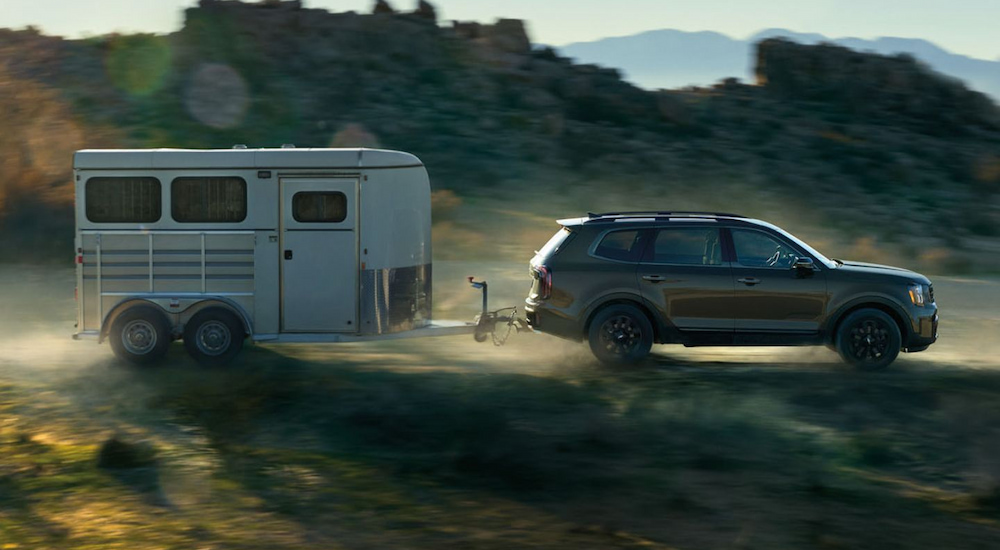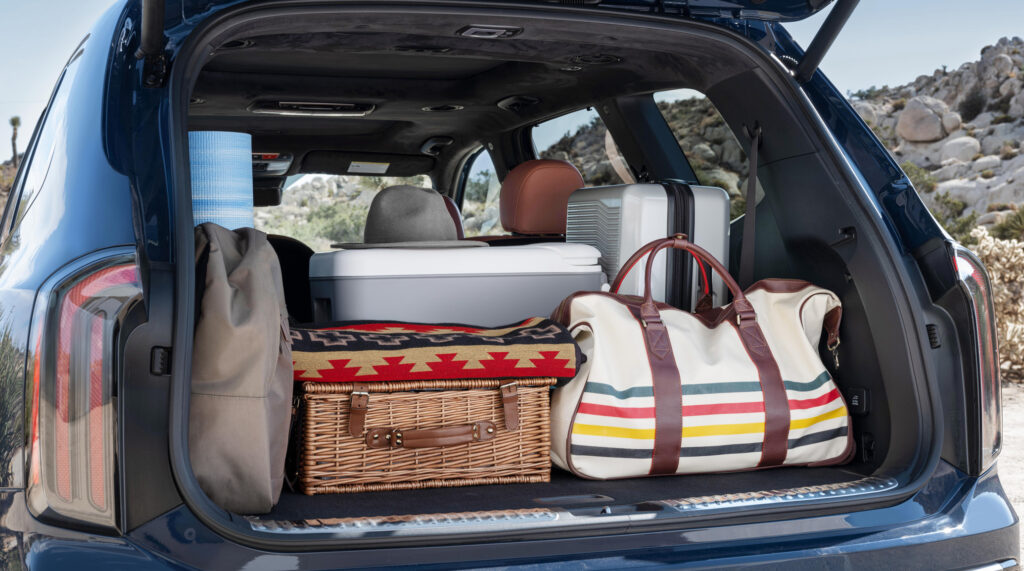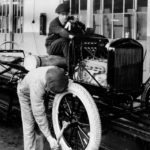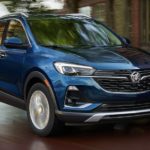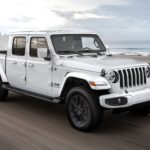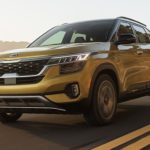Kia has never had much of a presence in the pickup segment, at least in the US. But when it comes to the South Korean brand’s home soil, it’s a whole different story. From an early T-600 “sambari” or “ three-footed vehicle” to the K-Series trucks that are a part of everyday life in Southeast Asia, Kia is no stranger to the world of pickups. Those decades of experience look to be paying off, with Kia set to introduce its new Tasman pickup in 2025. While the truck will initially be limited to the international market, the midsize model looks like it has all the size, power, and cargo capacity needed to compete in the US.
The new pickup might be a first for the brand, but it’s really not that much of a departure when you look at the rest of the lineup. Models like the Kia Telluride offer all the utility of a pickup in a midsize crossover package, and Kia’s parent company already produces a pickup for North American drivers in the form of the Hyundai Santa Cruz. As we await the (possible) arrival of the Tasman, we thought it would be a good time to look back on Kia’s pickup resume, track the evolution of some popular overseas models, and see how existing vehicles like the Kia Telluride are filling the current gap in the market.
Pickups of the Past
While Kia might not currently be known as a pickup truck brand, the segment actually plays an important role in the company’s history. Originally a bicycle manufacturer, Kia made the jump to the automotive market in the late 1950s when they started producing small motorcycles and trucks under licenses from Honda and Mazda. Kia eventually progressed to producing its own Brisia, but it was another collaboration with Mazda that would give birth to the first Kia pickup.
Known as the T-600, the short, three-wheeled vehicle certainly wouldn’t meet the definition of a pickup in the eyes of most American drivers, but it was well-suited for Korea’s domestic market. The T-600’s cargo bed and diminutive size made it perfect for delivering rice and coal through the narrow alleys of Korean cities. Unfortunately, it wasn’t wasn’t long for this world. The Korean government banned three-wheeled vehicles from using the nation’s highway system in 1972 amid a wave of accidents, and the T-600 was discontinued shortly after.
Kia would find success with its Brisa range of cars throughout much of the 1970s, but production was halted when a new military dictator came to power in 1981. This led Kia to place a renewed focus on the light truck market, with the next Kia pickup coming in the form of the Bongo. Also known as the Kia Besta or K-Series, the cab-over pickup truck, which was also offered as a van, would hit the streets in 1980. Originally outfitted with a four-cylinder diesel engine, the rear-wheel drive Bongo would become a staple commercial vehicle throughout Southeast Asia. The Bongo would see many variations over its first generation, from the Wide Bongo and Power Bongo to the Ceres, an agriculturally-focused model with a longer front end. The Bongo has continued to find success throughout its four generations, evolving with the times to meet changing needs. The most recent evolution came in the form of an EV version launched in 2020.
The North American market might be behind the curve when it comes to Kia’s pickup plans, but there have been some hints that something was in the works. In 2009, Kia teased the “Soul-ster” at the Detroit Auto Show. Based on the recently debuted Kia Soul, the Soul-ster was a half-SUV, half-pickup aimed at a young, hip demographic that was designed with an open top, roll-bars, and a fold-down rear seat that extended the small bed’s cargo capacity. The Soul-ster never entered widespread production, but it served as a good litmus test in gauging the market for a Kia pickup. “The response was so overwhelming,” said Kia Motors America spokesman Alex Fedorak. “It is clearly a vehicle that was built as a concept in a fashion that was production-capable. We have been doing that more and more lately.”
The Telluride Fills a Niche
The Kia Telluride is about as close as the company has come to offering a pickup for North American drivers. Introduced in 2019, the three-row crossover is the largest vehicle KIa has ever manufactured in the US. Packed with a 291-horsepower V6, eight-speed automatic transmission, and available all-wheel drive, the 2024 Telluride can hold its own against much of the midsize pickup segment. The roomy crossover might lack the body-on-frame construction of a typical truck, but it can still tow up to 5,500 lbs and hold its own when it comes to light off-road use, thanks to its 8.4 inches of ground clearance.
That’s especially true of the Telluride’s X-Pro trims, which add knobbier all-terrain tires, 18-inch wheels, and raised roof rails to the equation. The X-Pro also features a modest 0.4-inch suspension lift, but it’s the SUV’s Downhill Brake Control (DBC) feature that really sets it apart from your garden-variety crossover. Perfect for tackling steeper grades, DBC enhances a driver’s confidence and control by taking over braking duties. Simply activate DBC, set a desired speed, and the system will leverage the Telluride’s traction control and anti-lock brakes to ease you down a hill while minimizing wheel slip. This automated system allows the driver to concentrate on the road ahead instead of fussing with the brake pedal, giving them the opportunity to spot potential obstacles and keep the vehicle centered on challenging terrain.
The Telluride might lack the cargo bed that truly makes a pickup a pickup, but that doesn’t mean it lacks cargo space. The rear cargo area can accommodate 21 cu.ft. of gear, but that number expands to 46 cu.ft. with the second row folded and as much as 87 cu.ft. when both rows are stowed away. That’s enough room for 35 pieces of carry-on luggage, a whole little league team’s worth of sports equipment, or even some outdoor gear like mountain bikes or a kayak. The Telluride has found great success in the highly competitive crossover segment, making it the perfect starting point for Kia’s forthcoming Tasman pickup.
Tasman-ia
The 2024 Busan Motor Show serves as the coming-out party for Kia’s newest pickup creation: the Tasman. Inspired by the demanding terrain of the Australian state of Tasmania, the prototype pickup turned some heads while announcing Kia’s pickup ambitions to the world. It’s important to take this sort of auto show appearance with a grain of salt, but the forthcoming Kia pickup has been all but confirmed by the South Korean automaker. The Tasman will initially debut on the international market in 2025 with a focus on Korea, Australia, Africa, and the Middle East, but given America’s penchant for all things pickup, it’s hard to see the US missing out.
Details are still hard to come by when it comes to the Tasman, but that doesn’t mean Kia is leaving us totally in the dark. In a departure from Kia’s recent wave of all-electric models, the midsize Tasman will feature a good old-fashioned gas-powered engine under the hood. That might disappoint some drivers, but it is sure to increase the pickup’s profile among those who prefer a more traditional powertrain. Most importantly, the Tasman will be built with the conventional body-on-frame construction common to much of the pickup segment. This approach serves as a clear statement of intent from Kia and will distinguish the Tasman from crossover-based compact pickups like the Ford Maverick and Hyundai Santa Cruz to put it in league with the likes of the Toyota Tacoma, Chevy Colorado, and Ford Ranger. Body-on-frame design has long been seen as the gold standard in the pickup segment, allowing automakers to produce rugged trucks that can tackle tough jobs and off-road terrain without succumbing to the bumps, bruises, and twisting forces that can sideline some crossover models.
Early promotional material and reporting clue us in to some of the specifics when it comes to the Tasman, including a split tailgate, a dual cab design, and a spacious cargo bed that can be easily accessed via integrated steps. When it comes to the interior, the Tasman takes clear inspiration from the EV9, featuring a similar dual-screen display that pulls double duty as a digital gauge cluster and touchscreen infotainment system. Optional equipment will likely include a sunroof and memory seats, though we’re most interested in seeing what’s packed under the hood. The Tasman is expected to share a number of features and design cues with the Telluride, from its unique, squared-off shape and size to its all-terrain tires and off-road capability.
But the Tasman might just represent the opening volley in Kia’s full-on pickup assault, as the company has been toying with the idea of an electric pickup based on the shared Kia/Hyundai E-GMP platform for at least a couple of years. Sources have even spotted a camouflaged electric Kia pickup doing the rounds in Death Valley, which would seem to indicate an eventual US debut. Only time will tell how grand Kia’s pickup ambitions might be, but given the recent success of all-electric models like the Kia EV6, EV9, and Niro EV, we’d certainly like to see what they could bring to the pickup segment. Kia’s experience should serve the brand well as it looks to roll out the Tasman, but whether the automaker can break into the hotly contested North American pickup market is another question altogether. We always welcome a little competition, especially from a brand known for producing affordable models that can accommodate almost any budget.

